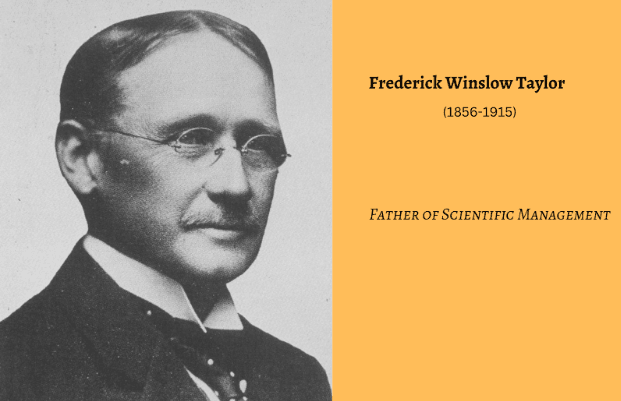Scientific management refers to transforming the way companies operate and manage their workforce. As its name indicates, this theory of management evaluates work processes through scientific methods. The scientific method comprises three steps: observation, experimentation, and evaluation. It may include testing various treatments, monitoring the impacts, and evaluating the results in science. Similarly, managers conduct workplace observations, test multiple task-completion approaches, and analyze them using scientific management theory.
Frederick Taylor’s Theory of Scientific Management

Frederick Taylor (1856-1915), often called the father of scientific management, played a pivotal role in its development. In 1909, Taylor published “The Principles of Scientific Management.” He suggested that work would become more productive by streamlining and optimizing tasks. He also promoted the notion that managers and employees should work together. Since Taylor thought money was the driving force behind all labor, he suggested the idea of “a fair day’s pay for a fair day’s work.”
Since Taylor studied Mechanical engineering, efficiency was an important subject for him. He made numerous design experiments before creating a shovel that workers could use for extended periods. Additionally, he studied the best practices for performing various tasks in the workplace by employing the scientific method. Taylor discovered the “best” method to finish a task by calculating each employee’s time.
The Principles of Scientific Management
Four fundamental principles of Taylorism scientific management are still applicable to modern organizations.

Science, Not a rule of thumb: Taylor recommends following scientific management practices instead of the rule of thumb. In general, each manager responds to a situation as it comes up. To solve a problem, they employed the trial-and-error approach. Taylorism suggests that managers study different conventional methods and adopt the best solution. This type of scientific management dramatically reduces costs and improves efficiency.
Harmony, not discord: This principle states that managers and employees should keep a harmonious work environment. Taylor highlighted the need for a mental revolution. Management and workers should work in harmony towards the organization’s common goals.
Personnel Development: The individual competencies of the employees determine the organization’s overall efficiency. The goal of scientific management was to maximize each employee’s working capabilities. To increase laborers’ productivity, it strongly emphasized their training and development.
Maximum output, in place of restricted output: Instead of aiming for limited production, the management and the workforce should strive for the total output. Both parties will benefit from this. Producing at maximum capacity will increase management profit and worker wages.
Contributions of Scientific Management Theory
Taylorism has several applications in managing different companies, associations, and sectors. Some of the contributions are;
- Scientific management introduced logical and systematic approaches to industrial and administrative problem-solving through its scientific methods.
- High productivity and efficiency methods aid mass production.
- Emphasis on hiring, evaluating, and compensation of employee; which are critical for improving efficiency.
- Recommending studies on rate setting, motion, fatigue study, and time to build a management system to increase production.
Constraints of Scientific Management Theory
Although it has a remarkable contribution, a few constraints are associated with scientific management theory.
- Scientific management considers humanity as a machine. As a result, employees perceive more exploitation, which raises the turnover rate.
- One employee must report to various supervisors, which is challenging for the unity of command. It leads to disarray and uncertainty within the organization.
- Under the guise of specialization, workers repeatedly work on the same activity, making such tasks monotonous and lacking initiative.
Finally, scientific management theory’s core idea is applying scientific instruments, processes, and strategies to raise corporate productivity and efficiency.
Although the principles of scientific management have had a significant impact on modern management practices, it is crucial to balance these ideas with an awareness of the human element of work and the dynamic nature of modern organizations.
